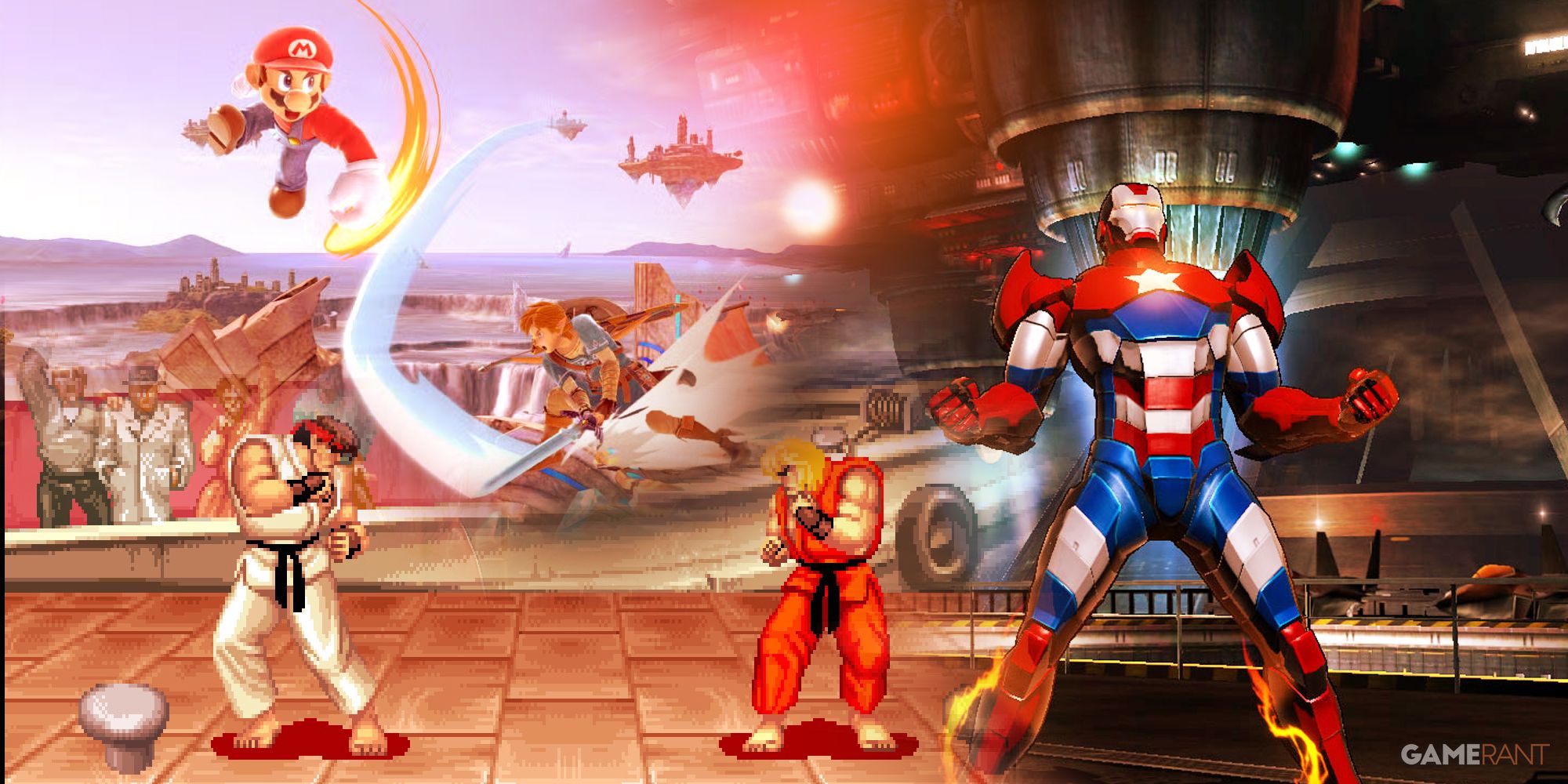Sega’s Virtua Fighter broke the mold as, though its blocky graphics are quaint today, it made using 3D figures in gaming seem like a palatable proposition. According to former Sony Computer Entertainment executive producer Shigeo Maruyama, it was one of the main reasons they decided to make the PlayStation a 3D-capable device.

Related
Most Timeless Fighting Games, Ranked
When it comes to timeless fighting games that can be enjoyed today, these examples are just the tip of the iceberg.
As such, it soon became the main home for 3D fighters and produced some classic games like Tekken 2 and Bloody Roar. Most of its best entries either had ports to other machines or got re-released either digitally or as part of a compilation. But there are a few notable entries that, for now, can only be played on the original PlayStation.
7
Tobal No.1
Behind in Sales, But Ahead of its Time
- Developer: DreamFactory.
- Platform: PS1.
- Release: October 1996.
Aside from being inspired by VF1, the PS1 managed to house its first true rival in Tekken. Namco’s game was made by many ex-Sega AM-2 staff and was designed with the PS1 in mind. Its arcade board was essentially a PS1 with more memory, and its port became the first title to sell over 1 million units on the console. But after designing Tekken, designer Seiichi Ishi and his staff left to form DreamFactory, where they made some unique fighting games for Squaresoft.
Tobal No.1 was the first, and it offered smooth 60FPS brawling gameplay, characters designed by Dragon Ball’s Akira Toriyama, and a unique RPG-esque, dungeon-crawling quest mode. Its most intriguing feature was its grapple/counter system, where the characters could grab their opponents in all sorts of ways, be it from the sides, from behind, or by catching the opponent’s attack. Then they could do one command or another to do different attacks and throws from that position. It’s standard for 3D fighters today, but it was quite inventive in 1996.
6
Tobal 2
A Hidden Gem with a Titanic Roster
- Developer: DreamFactory.
- Platform: PS1.
- Release: April 1997.
Unfortunately, Tobal No.1 wasn’t a success but has gained cult fame for its unique features. If it did better, Western fans might’ve gotten their hands on the sequel, Tobal 2. It carried over its neat grapple/counter gameplay, while also giving each character a special unblockable fireball move players could use if they were in trouble.
It also brought back the Quest Mode, except players were able to capture its monsters and make them playable in the main game. Most of them are model swaps with identical moves, but it was still enough to give it over 200 playable characters. One of which was a Chocobo from Final Fantasy. It’s an interesting addition, given DreamFactory would later get to use FF7’s Cloud, Tifa, and Sephiroth in Ehrgeiz: God Bless the Ring.
Changing the Clash of Superheroes to Fit into Sony’s Gray Box
- Developer: Capcom.
- Platform: PS1.
- Release: January 2000.
Hold on, Marvel Vs Capcom? This game has been ported and re-released on all sorts of machines! It’s even in the Marvel Vs Capcom Fighting Collection. So, why is it here? Because the PS1 version of the game is a stranger beast than its arcade original. It changed so much to fit onto Sony’s hardware that it’s practically a separate game on its own.
4:18

Related
Every Game In The Marvel Vs Capcom Series, Ranked From Worst To Best
The Marvel vs. Capcom series is a beloved one by fighting game and comic fans alike, but how do all of its entries stack up?
For one, players can’t tag in battle. Instead, their partner acts as an assist option, alongside the game’s original assist characters. Both can be used infinitely, which can lead to some busted combos. As can the super moves, as they can now be canceled into each other. People can also play as Onslaught, and use the Magnetic Shockwave as Mega Man instead of leaving it as an ending gag. It’s not better than the real deal, but it’s worth experiencing just because of how surreal it is for a port.
4
Street Fighter EX+ Alpha
A Heavy, Polygonal Dose of Nostalgia
- Developer: Arika.
- Platform: PS1.
- Release: October 1997.
Nowadays, people might be more familiar with Street Fighter EX+ Alpha than its EX and EX+ arcade originals. Particularly on the audio front, as the arcade tunes feel incomplete compared to their remixes on the PS1. They also don’t have what’s possibly its most famous tune, ‘Precious Heart’, a peppy saxophone-led theme that fighting game fans might recognize from the end of Maximillian Dood’s YouTube videos.
That’s because this 90s school-set anime-sounding tune was made for Sakura, who was one of the port’s newcomers alongside Dhalsim. The game also introduced the combo trial mode, where players had to complete a different series of combo challenges. It was a neat addition that Capcom would bring back to the SF series in Street Fighter 4 onward. For a PS1 fighter that looked blocky even back in 1997, EX+A is more influential than it looks.
3
Street Fighter EX2 Plus
A Double Dose of EX Action
- Developer: Arika.
- Platform: PS1.
- Release: May 2000.
That said, EX+A is a stiff game to play today. People can adjust to it, but playing Street Fighter in slow motion isn’t exactly a selling point. Street Fighter EX2 Plus smoothed things along by making the controls more responsive and introducing Excels. By pressing 2 buttons, players can use a third of their super gauge to temporarily chain any and every form of attack until it runs out. Otherwise, they can save all 3 super gauge chunks to unleash a Meteo Combo, an ultra-powerful (and often quite weird) super move that can eat up the opponent’s health bar.
It brought back the combo trials, alongside some key characters that were missing from the arcade original, like Bison and Darun, alongside some unique secret characters like the swordsman Hayate. EX2 Plus is better to play than EX+A, though it lacks endings, the ever popular Sakura, and has blander music, which might be why it’s not as fondly remembered as its predecessor.
2
Soul Blade
How the Stage of History Was Set Up
- Developer: Namco.
- Platforms: Arcade, PS1.
- Release: January 1997.
Most people got into the SoulCalibur series through the first game on the Dreamcast. It was the one that let them run around the stage in 8 directions, and smash people out of the ring with Ivy Valentine and her whip sword. But though it’s the first game to bear the name, SoulCalibur isn’t the first in the series. Namco’s tale of swords and souls began with Soul Edge, aka Soul Blade.

Related
Every Soulcalibur Game, Ranked
The Soulcalibur series is beloved by many fans of the fighting game genre, but which entry in the series stands as being the best of them all?
It introduced most of the series’ hallmarks, like the epic story-based Edge Master mode, its QTE-based endings (which returned for SoulCalibur 3), and its iconic characters like Siegfried, Sophitia and Taki. The game technically also has SC1’s big villain, Nightmare, as one of its many unlockable characters. He just wears red armor and is called Siegfried! (with the exclamation mark). While it hasn’t aged as well as its sequels, Soul Blade was a grand beginning to the series, and one of the PS1’s best fighters.
1
Tekken 3
The King of PS1 Fighters Remains Stuck on Its Throne
Tekken 3 is undoubtedly the best fighting game on the PS1. Some players might prefer its ports of the Street Fighter Alpha games or Dead or Alive (Why? They were better on the Saturn), but it’s the game that’s aged the best. It offers the smoothest controls, the best cinematics, and some of the genre’s most iconic characters in Jin Kazama, Hwoarang and Ling Xiaoyu, among others. Yet, unlike Tekkens 1 & 2, it’s never been re-released.
Not as a standalone title anyway. Its arcade version was in Tekken 5, and its stodgy PAL version was on the stodgier PlayStation Classic. The likely reason is that it featured the series’ first guest character, Gon. Like its ending cinematics and extra modes, this orange dinosaur was exclusive to the PS1 version. Unless Bandai-Namco pays up for his reappearance or finds some way to get him out of the game (if that’s even possible 27 years after its release), T3 is likely to remain locked to the PS1.

Related
6 Great Capcom Franchises That Seem Unlikely To Make A Comeback
These Cpacom franchises have most likely passed their peak performance period, giving them little to no chance at a comeback.





















Leave a Reply